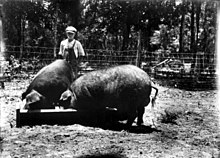The Poland China is an American breed of domestic pig. It was first bred in Warren County in Ohio, in the American Midwest. Its origins lie in a small number of pigs of Chinese type bought in 1816, which were cross-bred with a variety of breeds of European origin including the Berkshire. It was bred as a lard pig, and is among the largest of all pig breeds.[2]: 535 [3]: 193 [4]
 Poland China boars in Florida in about 1917 | |
| Conservation status | FAO (2007): not at risk[1]: 148 |
|---|---|
| Other names |
|
| Country of origin | USA |
| Traits | |
| Weight |
|
| |
It is the oldest American breed of swine.
History
editThe origins of the Poland China lie in the purchase in Philadelphia in 1816 by John Wallace, a trustee of the Shaker Society of Union Village in Warren County, Ohio, of four pigs of the breed or type known as Big China;[2]: 535 [3]: 193 it is possible that they were in fact of the now-extinct Bedford breed.[2]: 535 Three sows and a boar were brought to the village of Union, where Shaker farmers cross-bred them with local pigs of the types known as Russia or Byfield, both large pale-skinned pigs. Further crossing with other breeds of European origin including the British Berkshire and the Irish Grazier – a slow-growing pig with good ability to forage for itself – led to the consolidation of a type which by about 1846 was usually known as the Warren County Pig, but also as the Poland or Big China.[3]: 193
The name Poland China was agreed on at a meeting of the National Swine Breeders Convention in Indianapolis in 1872;[3]: 193 at the same meeting the convention rejected the claim of David M. Magie, a successful Poland China breeder of the Austin-Magie Farm near Oxford, Ohio, to be the creator of the breed.[5]: 5 [6] The first pedigree was drawn up in Blue Ball, Ohio, by W.C. Hankinson and Carl Freigau in 1876, and a herd-book was started in 1878.[2]: 535 [7][4]
The breed became widespread in the United States, and by the end of the nineteenth century was among the most numerous pig breeds in the country. Numbers fell in the twentieth century as demand for lard decreased. In 1990 the registered population was about 18000 head.[3]: 193 [a] In 2018 a total population of 12300 was reported.[4]
The Poland China was reared in large numbers in Argentina, principally for export. In 1944 about 1.3 million head were slaughtered, approximately a third of total production.[2]: 541
In the 1920s and 1930s, agricultural reformers introduced the Poland China pig into China, with mixed success. The pigs were not adapted to the climate, and Chinese farmers were more interested in a pig's ability to produce fertilizer than its meat capacity.[8]
Characteristics
editThe Poland China usually displays the coloration of the Berkshire: solid black, with white points on the nose, tail and feet. It is a large pig, heavy-jowled, lop-eared and short-legged.[3]: 193 It is among the heaviest of pig breeds: sows average some 240 kg, boars about 50 kg more.[4] The heaviest pig on record is a Poland China named Big Bill, who in Tennessee in 1933 was found to weigh 1158 kg (2552 lb), with a length of about 2.75 m (9 ft).[3]: 173
Notes
edit- ^ For comparison, the corresponding figure for each of the three dominant breeds – the American Yorkshire, the Duroc and the Hampshire – was more than ten times greater.[3]: 194
References
edit- ^ Barbara Rischkowsky, Dafydd Pilling (editors) (2007). List of breeds documented in the Global Databank for Animal Genetic Resources, annex to The State of the World's Animal Genetic Resources for Food and Agriculture. Rome: Commission on Genetic Resources for Food and Agriculture, Food and Agriculture Organization of the United Nations. ISBN 9789251057629. Archived 23 June 2020.
- ^ a b c d e Valerie Porter, Lawrence Alderson, Stephen J.G. Hall, D. Phillip Sponenberg (2016). Mason's World Encyclopedia of Livestock Breeds and Breeding (sixth edition). Wallingford: CABI. ISBN 9781780647944.
- ^ a b c d e f g h Janet Vorwald Dohner (2001). The Encyclopedia of Historic and Endangered Livestock and Poultry Breeds. New Haven, Connecticut; London: Yale University Press. ISBN 0300088809.
- ^ a b c d Breed data sheet: Poland China / United States of America (Pig). Domestic Animal Diversity Information System of the Food and Agriculture Organization of the United Nations. Accessed May 2021.
- ^ Joseph Ray Davis, Harvey Samuel Duncan (1921). History of the Poland China Breed of Swine, volume 1. [s.l.]: Poland China History Association.
- ^ Lucy Curry (1978). The Felix Fryman Farm House. Columbus, Ohio: Ohio Historic Preservation Office. Accessed May 2021.
- ^ Search result: All fields: Hankinson. MidPointe Library System. Archived 4 March 2016.
- ^ Sigrid Schmalzer (2002). Breeding A Better China: Pigs, Practices, and Place in a Chinese County, 1929–1937. Geographical Review. 92 (1): 1–22. doi:10.1111/j.1931-0846.2002.tb00131.x. (subscription required).